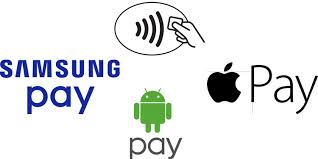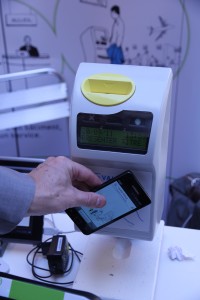
March 3rd, 2016 by Elma Jane
Apple and Samsung, Plus HCE, Lending Momentum to Contactless
EMV migration in the U.S. is helping to establish NFC since nearly all EMV terminals come with built-in NFC capability. Consumers worldwide will make mobile payments with their handsets using near-field communication this year, nearly 70% will be Apple Pay and Samsung Pay users.
Some banks were offering mobile wallets based on HCE. Banks have responded to HCE because its cloud configuration stores and manages payments information, bypassing the secure element in the phone. This allows banks to introduce tap-and-pay mobile-payments services quickly because it eliminates the need to negotiate terms with mobile carriers and device manufacturers to gain access to the secure element. Cloud-based credentials can be tokenized to protect from hackers. Tokenization and HCE combination is extremely attractive to banks.
Apple, Samsung and a cloud-based technology host card emulation are playing a big role in spreading contactless payments.
Posted in Best Practices for Merchants, EMV EuroPay MasterCard Visa, Mobile Payments, Mobile Point of Sale, Near Field Communication, Smartphone Tagged with: banks, consumers, contactless, contactless payments, EMV, HCE, host card emulation, mobile, Mobile Payments, mobile wallets, Near Field Communication, nfc, payments, terminals, tokenization

December 16th, 2015 by Elma Jane
Google’s contactless payment solution, Android Pay, will now be available through the mobile checkouts of several Android apps in the U.S.
With this addition, it avoids having to pull out your card everytime you make a purchase, meaning card data never makes it to the merchants. A good news for anyone who is concerned about privacy.
Android Pay is compatible with all Near Field Communication (NFC) or Host Card Emulation (HCE) enabled devices using any OS released since KitKat.
With Coca-Cola signing up as the first merchant in the Google program, a new loyalty program was recently released for the mobile wallet, by tapping your phone on an NFC-enabled Coke vending machine, you’ll get a Coke and get points added into your Android Pay Account for future purchases.
http://www.pymnts.com/news/payment-methods/2015/android-pay-now-in-app-payment-option/
Posted in Best Practices for Merchants, Credit Card Security, Mobile Payments, Smartphone Tagged with: Android Pay, card, card data, contactless payment, HCE, host card emulation, loyalty program, merchants, mobile wallet, Near Field Communication, nfc, payment
April 11th, 2014 by Elma Jane
A new standard that uses Host Card Emulation (HCE) was introduced by VISA to enable financial institutions to securely host Visa accounts in the cloud. Visa’s move to support HCE includes tools and services as well as the standard. It is available now and will include support for QR codes and in-app payments in the future.
With this new service and platform that Visa is developing, it will enable clients and partners to issue Visa accounts digitally in the cloud, on secure elements in smartphones, or linked to a digital wallet. The solution will also enable the issuance of payment tokens that will replace the 16-digit payment account number and can be limited for use with a specific device, merchant or payment channel.
Layers of security will deploy by Visa to protect payment accounts in the cloud, including at the Visa network, application and hardware levels. Device fingerprinting technology, one-time use data, payment tokens and real-time transaction analysis will make up a multi-layered defense against unauthorized account access for their services.
Visa has intensified its Visa PayWave contactless payment application and is introducing a new implementation guidelines, program approval process standard and requirements for their standards.
Visa is also developing a tool, its software development kit (SDK) to support clients who wish to develop their own cloud-based payment applications or want to enhance their existing mobile banking applications with Visa PayWave functionality.
HCE is introduced to make it easier for developers to create NFC applications like mobile payments, loyalty programs, transit passes, and other custom services. Visa’s move to enable NFC payments with Android devices is welcome news and will guide the way for the payments industry.
Clients and partners around the globe are continuously looking for cost efficient, flexible and secure ways to enable mobile payments. The Android HCE feature provides with a platform to evolve the Visa PayWave standard, support the development of secure, cloud-based mobile applications, while at the same time offer greater choice.
Posted in Best Practices for Merchants, Credit card Processing, Credit Card Security, Electronic Payments, Financial Services, Merchant Services Account, Mobile Payments, Mobile Point of Sale, Near Field Communication, Smartphone Tagged with: accounts, android devices, approval, cloud, cloud-based mobile applications, contactless payment, device fingerprinting, Digital Wallet, digitally, financial institutions, HCE, host card emulation, in-app, mobile banking, nfc, payment account number, payment channel, payment tokens, payments, qr codes, real-time transaction, secure elements, securely, Smartphones, unauthorized, visa, visa network
November 7th, 2013 by Elma Jane
Android 4.4 introduces an additional method of card emulation that does not involve a secure element, called host-based card emulation. This allows any Android application to emulate a card and talk directly to the NFC reader. This document describes how host-based card emulation (HCE) works on Android and how you can develop an app that emulates an NFC card using this technique.
Many Android-powered devices that offer NFC functionality already support NFC card emulation. In most cases, the card is emulated by a separate chip in the device, called a secure element. Many SIM cards provided by wireless carriers also contain a secure element.
Card Emulation with a Secure Element
The secure element itself performs the communication with the NFC terminal, and no Android application is involved in the transaction at all. After the transaction is complete, an Android application can query the secure element directly for the transaction status and notify the user.
When NFC card emulation is provided using a secure element, the card to be emulated is provisioned into the secure element on the device through an Android application. Then, when the user holds the device over an NFC terminal, the NFC controller in the device routes all data from the reader directly to the secure element.
Host-based Card Emulation
The NFC standards offer support for many different protocols, and there are different types of cards that can be emulated. When an NFC card is emulated using host-based card emulation, the data is routed to the host CPU on which Android applications are running directly, instead of routing the NFC protocol frames to a secure element.
Android 4.4 supports several protocols that are common in the market today. Many existing contactless cards are already based on these protocols, such as contactless payment cards. These protocols are also supported by many NFC readers in the market today, including Android NFC devices functioning as readers themselves. This allows you to build and deploy an end-to-end NFC solution around HCE using only Android-powered devices.
Posted in Electronic Payments, Mobile Payments, Near Field Communication, Smartphone Tagged with: 4.4, Android, app, card, cards, communication, contactless, controller, cpu, data, emulation, HCE, host, nfc, notify, payments, protocols, query, reader, routes, secure element, sim, status, terminal



